Yes, I used the circular saw blade for the kerfs, about 4 mm wide. And the MDF I used was of a not very flexible type. I would only consider such a technique for much bigger bending radiusses and multiple sheets.Your kerfs look a little wide, and your radius a little tight.
And then I'm not so sure I would really make all those long cuts ...
Prefabricated material is defenitely better!
Did you use it for a speaker project?to get it to do what I was asking.
Yes, but it was a small desk speaker, so the rigidity required wasn't extreme. The cross section was basically elliptical, which also helped stiffen things. A couple pics from the middle of construction:


They were ultimately veneered, but I don't have pictures handy of their completed state.
They were ultimately veneered, but I don't have pictures handy of their completed state.
I happened across this thread while contemplating an on-wall speaker build. I'd like to contribute where I can. I'm not an acoustics expert. I can code in Python, and have some background in electronics. Anyway, happy to help where I can.
Low cost wall speaker building progress:
First very rough measurements ...
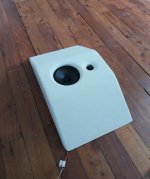
The speaker rests on the floor, mic at 50 cm above.
One advantage of a wall speaker is the extended gating window duration of ~11 ms 🙂
Response 0°, 30°, 60°:
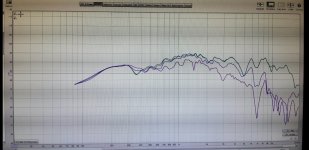
The cancellation at 350 Hz is the result of a (mild) reflection of the floor, next to the slanted baffle sides and the more pronounced step at the top and bottom of the speaker.
Baffle step can be seen above ~600 Hz.
Driver: visaton fr10 without whizzer cone, see here.

The speaker rests on the floor, mic at 50 cm above.
One advantage of a wall speaker is the extended gating window duration of ~11 ms 🙂
Response 0°, 30°, 60°:

The cancellation at 350 Hz is the result of a (mild) reflection of the floor, next to the slanted baffle sides and the more pronounced step at the top and bottom of the speaker.
Baffle step can be seen above ~600 Hz.
Driver: visaton fr10 without whizzer cone, see here.
By the way, I suspect the 3 kHz wiggle may be result from the rear mounted driver. I will try to reduce the thickness of the exposed baffle edge by countersinking the driver from behind.
The crossover frequency to the tiny 14 mm polycarbonate tweeter will be around 4 kHz.
This is a very low cost and driver recycling project, to be installed for background music in the local maker space.
The crossover frequency to the tiny 14 mm polycarbonate tweeter will be around 4 kHz.
This is a very low cost and driver recycling project, to be installed for background music in the local maker space.
Following my experiences, if you will make it 2,5way with another woofers in the side panels, with right placing they will fill cancellation and also compensate lower sensitivity in low mids and bass regions + theoreticaly with good design they will help with horizontal directivity control in that region
Just noticed this thread. I think this paper will be useful:
https://jeeit.feit.ukim.edu.mk/index.php/jeeit/article/view/347/328
https://jeeit.feit.ukim.edu.mk/index.php/jeeit/article/view/347/328
^That isn't optimal either, there is lobing "behind a woofer box" implemented like this makes null toward listening spot (assuming stereo listening triangle) and high power exactly in front. This might be fine for a small on wall speaker, but I used this with relatively big bass box and it's not a good compromise on low mids, makes either thin sound on the spot or quite dark sound to side of it. If you onwall speaker like so, make the box as thin and slim as possible to get shortest possible path length around the box, or make it have a toe-in.
While this could be acceptable compromise for a wall mount speaker it's just another compromise among any other style on wall box.
While this could be acceptable compromise for a wall mount speaker it's just another compromise among any other style on wall box.
I don't understand this. With conventional on-wall speakers (drivers in front) there will be a null toward lower frequencies, which is more objectionable.implemented like this makes null toward listening spot (assuming stereo listening triangle) and high power exactly in front.
Big bass box will introduce more artefacts than small (i.e. adequate) box.I used this with relatively big bass box and it's not a good compromise on low mids, makes either thin sound on the spot or quite dark sound to side of it.
Why big bass box? It is against the design requirements from post #1:
Outline speaker design:
...
- 60 - 20kHz passband with subwoofer support below 80 Hz
Hi, mentioned that I tried this arrangement with big bass box and with that I didn't like it due to low mids lacking at ~30deg listening angle, compared to exactly "behind" the box. Tonality changing radically in my situation was partly due to having toe-in with narrow coverage top box but not with the bass box, magnifying the effect. Sound changed dramatically when listener veered off from center position. I speculate driver toward wall could work with smaller box, where dimensions are minimized to push comb filter higher up in frequency, and toe-in is same for both bass and tweeter.
The paper considers the situation where observer is directly behind the box, but if you have a stereo listening triangle the listener is not directly behind a speaker but at an angle. Now path length from driver around the box toward listener is much longer around the other side than from the near side which creates a comb filter, starting at frequency where path length difference is 1/2 wl. If the box is big, the path length difference could be >50cm and null around ~300Hz or so, depending at which angle one is at. When observer is directly behind the box there is no path length difference for sound around either side and response is smooth as per in the paper. With a small box, say 10cm x 10cm x 10cm, the path length difference around the box could be about 15cm toward some listening triangle listening position. First null would be about at 30cm wavelength so around 1000Hz or something like that. If xo was at 2kHz, the woofer box would need to have < 17cm circumference, very very small, even a tweeter could have this big, so there is some combfilter, unless the listener is exactly behind "the box", iow the box is toed-in and not flat against the wall.
The paper considers the situation where observer is directly behind the box, but if you have a stereo listening triangle the listener is not directly behind a speaker but at an angle. Now path length from driver around the box toward listener is much longer around the other side than from the near side which creates a comb filter, starting at frequency where path length difference is 1/2 wl. If the box is big, the path length difference could be >50cm and null around ~300Hz or so, depending at which angle one is at. When observer is directly behind the box there is no path length difference for sound around either side and response is smooth as per in the paper. With a small box, say 10cm x 10cm x 10cm, the path length difference around the box could be about 15cm toward some listening triangle listening position. First null would be about at 30cm wavelength so around 1000Hz or something like that. If xo was at 2kHz, the woofer box would need to have < 17cm circumference, very very small, even a tweeter could have this big, so there is some combfilter, unless the listener is exactly behind "the box", iow the box is toed-in and not flat against the wall.
Last edited:
Your shape on the wallspeaker, is the shape my guru Albert Von Schweikert used in his 2 largest wallspeaker.First very rough measurements
Name on them is TS-200 and TS-150, and i have both of them.
Virtual Reality series from 1998-2003.
They are switchable between monopole and dipole operation via a switch, which allows tailoring the expansiveness / openness of the sound depending on the program materials.
The smaller TS-150 have 2 x 5,5" ported and 2 x tweeter, in two directions. (Dipole/monopole selection switch)
Power Handling: 200 watts nominal input (music power).
Crossover: Our proprietary Global Axis Differential Network enables either in-phase (monopole) or out-of-phase (dipole null) radiation patterns. Crossover point is 2.2 kHz.
Frequency Response: 40Hz to 25kHz +/- 3dB, (60Hz to 20kHz +/- 1.5dB) 20 kg
I have not find the manual for the TS-200, but its twice the seize and a "killer"
TS-200 has 3 x 6" ported and 3 tweeter, playing in 3 directions. (monopole / dipole surround speakers)
Attachments
-
 1292665-von-schweikert-audio-ts150-dipolemonopole-surround-speakers-in-maple-finish.jpg59.4 KB · Views: 20
1292665-von-schweikert-audio-ts150-dipolemonopole-surround-speakers-in-maple-finish.jpg59.4 KB · Views: 20 -
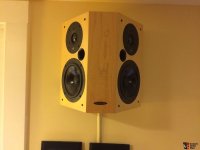 1292667-von-schweikert-audio-ts150-dipolemonopole-surround-speakers-in-maple-finish.jpg67 KB · Views: 21
1292667-von-schweikert-audio-ts150-dipolemonopole-surround-speakers-in-maple-finish.jpg67 KB · Views: 21 -
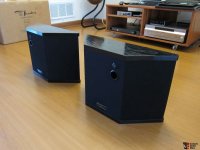 1836649-a-pair-of-von-schweikert-ts200-monopole-dipole-surround-speakers.jpg84 KB · Views: 19
1836649-a-pair-of-von-schweikert-ts200-monopole-dipole-surround-speakers.jpg84 KB · Views: 19 -
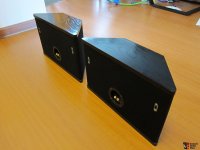 1836650-a-pair-of-von-schweikert-ts200-monopole-dipole-surround-speakers.jpg69.3 KB · Views: 16
1836650-a-pair-of-von-schweikert-ts200-monopole-dipole-surround-speakers.jpg69.3 KB · Views: 16 -
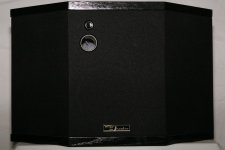 _MG_0476.jpg63.6 KB · Views: 16
_MG_0476.jpg63.6 KB · Views: 16
With 10x10x10 cm box at equal 4 cm distance from the wall (parallel to wall), in equilateral triangle with 360 cm side on the wall, at the listening position (312 cm from the wall) path difference will be 12.2 cm. So, the null is at 1445 Hz, not at 1000 Hz. But...With a small box, say 10cm x 10cm x 10cm, the path length difference around the box could be about 15cm toward some listening triangle listening position. First null would be about at 30cm wavelength so around 1000Hz or something like that
As you said, if the box is not at equal distance (flat) from the wall, but toed in - with inner vertical edge touching the wall, than there will be no null, if the box is a simple regular cuboid with height bigger than width.
They are surround speakers, not front L and R.the shape my guru Albert Von Schweikert used in his 2 largest wallspeaker.
Name on them is TS-200 and TS-150,
The paper considers the situation where observer is directly behind the box, but if you have a stereo listening triangle the listener is not directly behind a speaker but at an angle. Now path length from driver around the box toward listener is much longer around the other side than from the near side which creates a comb filter, starting at frequency where path length difference is 1/2 wl.
This depends very much on the design of the enclosure and the eventual phase plug - compare frequency responses in Fig. 7 and 8 to Fig. 10 and 11 in the paper from post #149. They are measured directly in front of the speaker ("on axis", 0 degrees), but with adequate phase plug (not fully optimized here) measurement at 30 degrees (not presented in the paper) is very good also:
Here null is at 1580 Hz, but is very narrow, although enclosure is not-so-small 18 cm diameter globe. Integration with a tweeter high-passed at 2 kHz with Linkwitz-Riley filter is very easy, leaving only very narrow and shallow notch at 1580 Hz.
- Home
- Loudspeakers
- Multi-Way
- High Fidelity On Wall Speaker Group Project